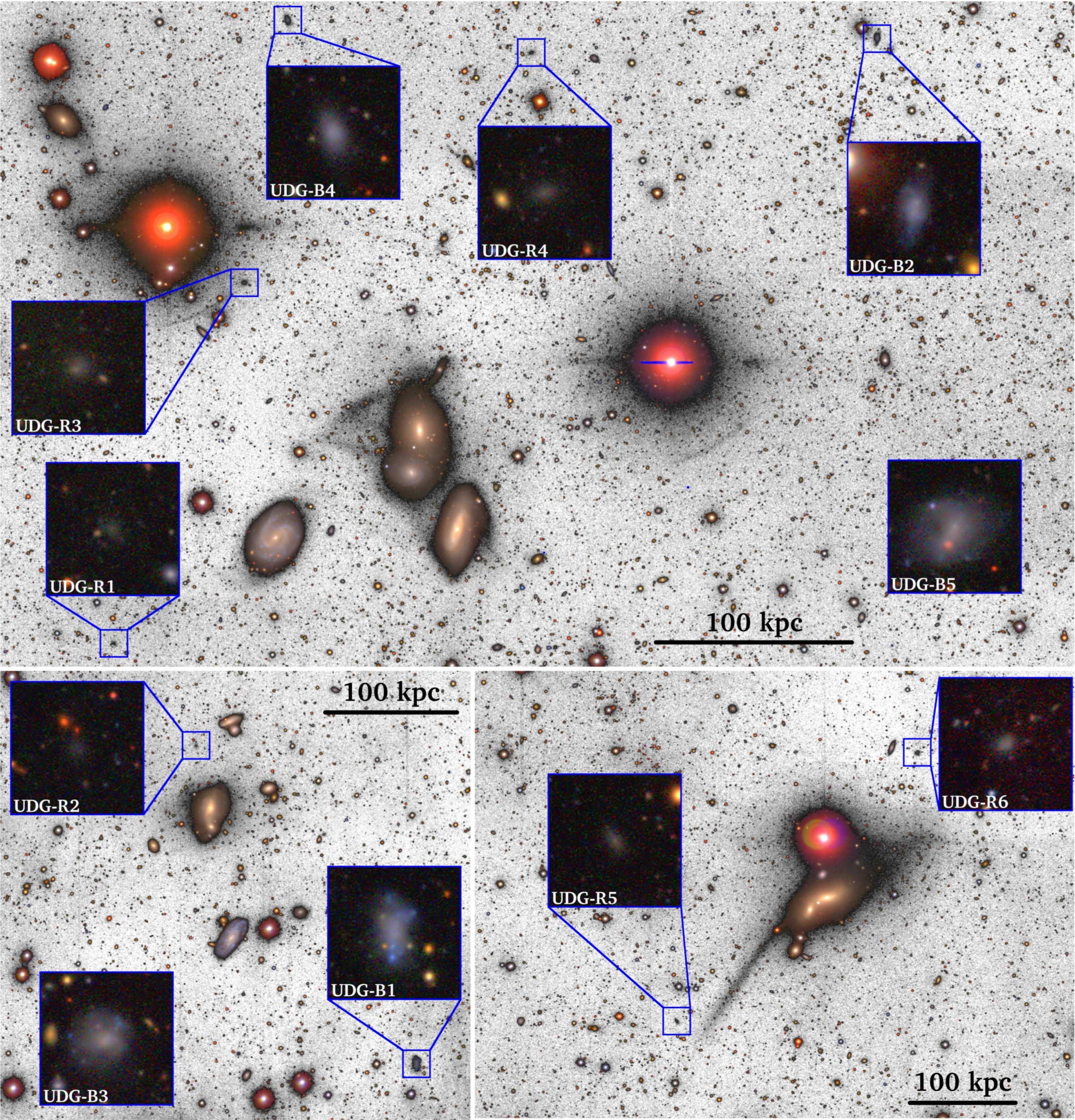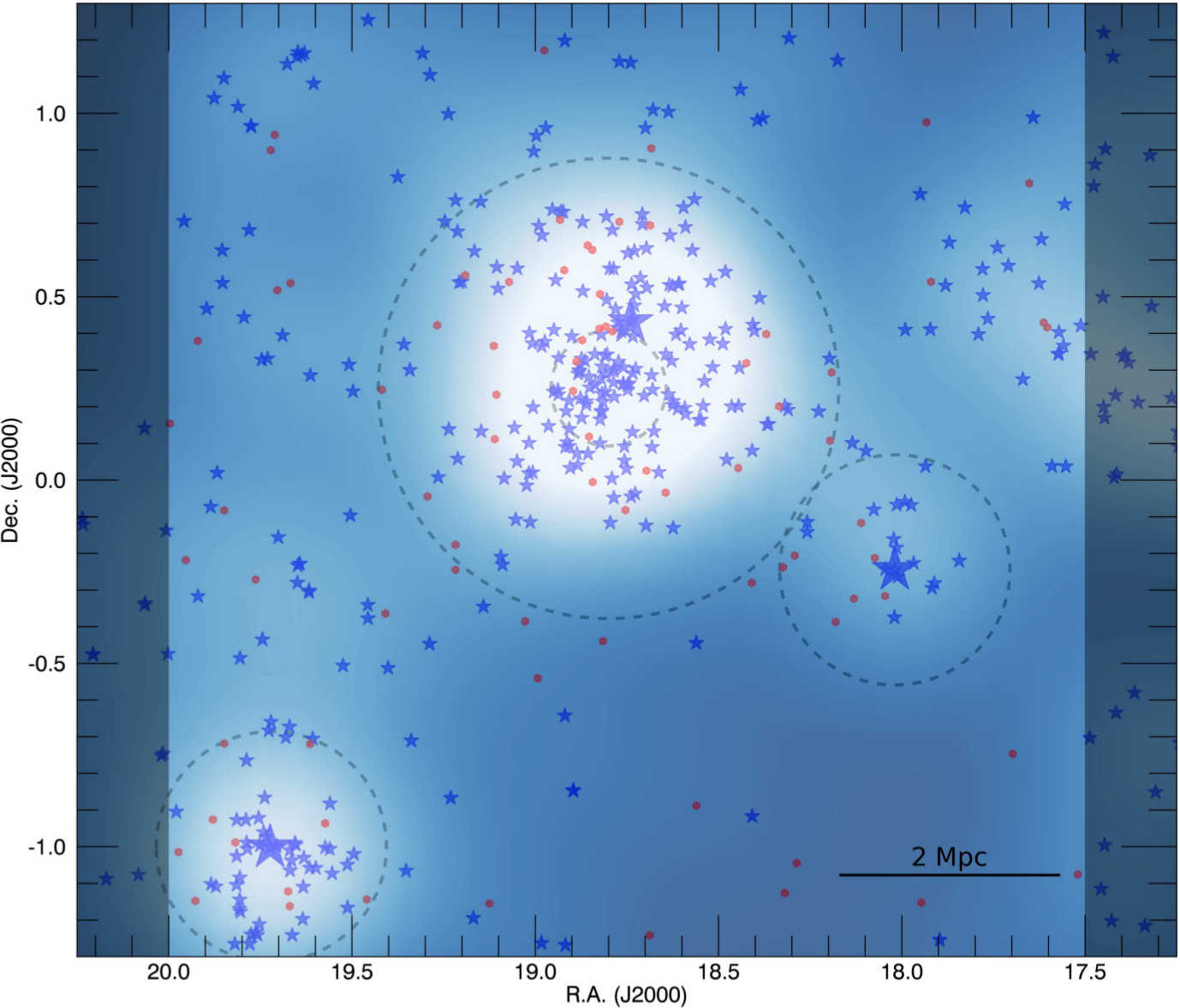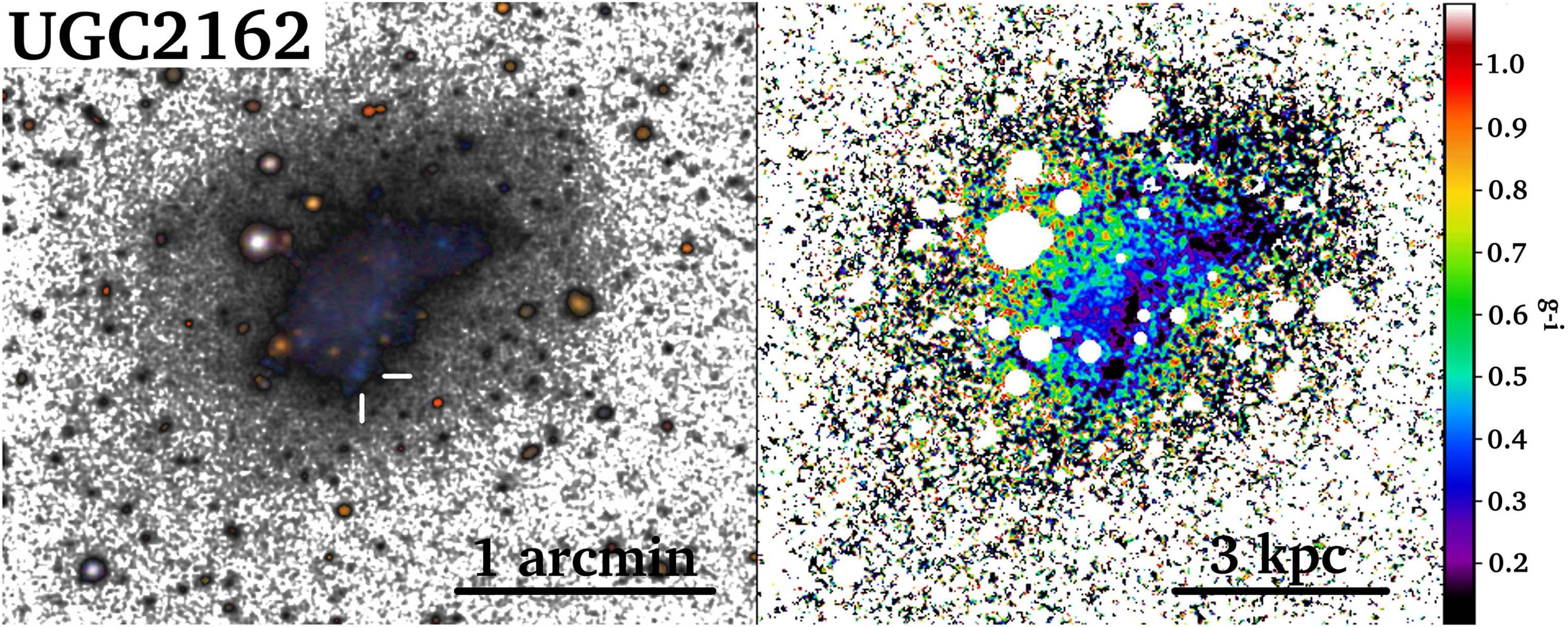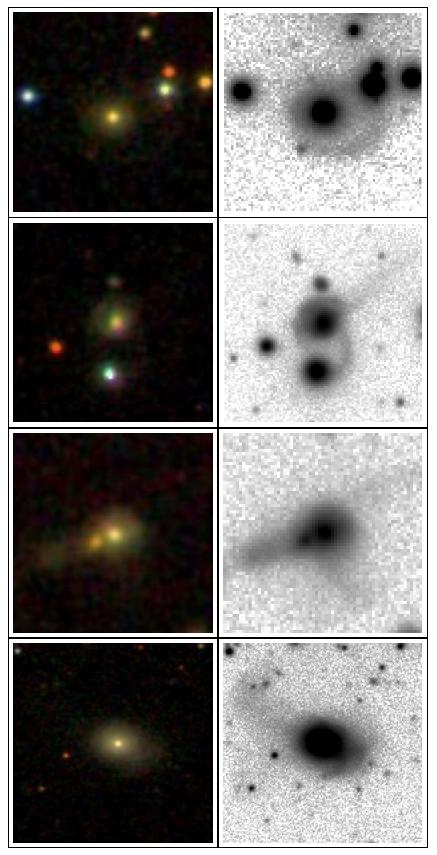Highlighted publications
Here we list some key publications that have made use of the deep images of the IAC Stripe82 Legacy Project. If you want your publication to be included here, please contact us.
Ultra-diffuse galaxies outside clusters: clues to their formation and evolution
Authors: Román & Trujillo (2017b)
Abstract:
We identify six ultra-diffuse galaxies (UDGs) outside clusters in three nearby isolated groups (0.014 < z < 0.026) using very deep imaging in three different Sloan Digital Sky Survey filters (g, r and i bands) from the IAC Stripe82 Legacy Project. By comparing with the abundance of UDGs in rich galaxy clusters, we find that the density of UDGs (i.e. their number per unit mass of the host structure where they are located) decreases towards the most massive systems. This is compatible with a scenario where UDGs are formed preferentially outside clusters. In the periphery (D > 250 kpc) of our three groups, we identify a population of potential UDG progenitors (two of them confirmed spectroscopically). These progenitors have similar masses, shapes and sizes but are bluer, g-i ~ 0.45, (and for this reason brighter, μ_g(0) < 24 mag arcsec⁻²) than traditional UDGs (g-i ~ 0.76). A passive evolution of these progenitors will transform them into regular (i.e. μ_g(0)> 24 mag arcsec⁻²) UDGs after ~6 Gyr. If confirmed, our observations support a scenario where UDGs are old, extended, low surface brightness dwarfs (M* ~ 10⁸ Msun) galaxies born in the field, are later on processed in groups and, ultimately, infall into galaxy clusters by group accretion.

Description of the image:
Ultra diffuse galaxies discovered around the Hickson compact groups HCG07 (upper panel), HCG25 (lower left panel) and HCG98 (lower right panel)
Spatial distribution of ultra-diffuse galaxies within large scale structures
Authors: Román & Trujillo (2017a)
Abstract:
Taking advantage of the Sloan Digital Sky Survey Stripe82 data, we have explored the spatial distribution of ultra-diffuse galaxies (UDGs) within an area of 8x8 Mpc² centred around the galaxy cluster Abell 168 (z = 0.045). This intermediate massive cluster (sigma = 550 km s⁻¹) is surrounded by a complex large-scale structure. Our work confirms the presence of UDGs in the cluster and in the large-scale structure that surrounds it, and it is the first detection of UDGs outside clusters. Approximately 50 % of the UDGs analysed in the selected area inhabit the cluster region (11 ± 5 % in the core and 39 ± 9 % in the outskirts), whereas the remaining UDGs are found outside the main cluster structure (50 ± 11 %). The colours and the spatial distribution of the UDGs within this large-scale structure are more similar to the dwarf galaxies than to L*galaxies, suggesting that most of UDGs could be bona fide dwarf galaxies.

Description of image:
Spatial distribution of ultra-diffuse galaxies (red dots) within the large-scale structure around the cluster Abell168 (blue stars)
The Nearest Ultra Diffuse Galaxy: UGC 2162
Authors: Trujillo et al. (2017)
Abstract:
We describe the structural, stellar population and gas properties of the nearest ultra diffuse galaxy discovered so far: UGC 2162 (z = 0.00392 Re,g = 1.7 (± 0.2) kpc; μ_g(0) = 24.4 ± 0.1 mag arcsec⁻², g-i = 0.33 ± 0.02). This galaxy, located at a distance of 12.3 (± 1.7) Mpc, is a member of the M77 group. UGC 2162 has a stellar mass of ∼ 2 × 10⁷ Msun and is embedded within a cloud of HI gas ∼10 times more massive: ∼1.9 (±0.6) × 10⁸ Msun . Using the width of its HI line as a dynamical proxy, the enclosed mass within the inner R ∼ 5 kpc is ∼4.6 (± 0.8) × 10⁹ Msun (i.e., M/L ∼ 200). The estimated virial mass from the cumulative mass curve is ∼8(± 2)×10¹⁰ M ⊙. Ultra-deep imaging from the IAC Stripe82 Legacy Project show that the galaxy is irregular and has many star-forming knots, with a gas-phase metallicity around one-third of the solar value. Its estimated star-formation rate is ∼0.01 Msun yr⁻¹. This SFR would double the stellar mass of the object in ∼2 Gyr. If the object were to stop forming stars at this moment, after a passive evolution, its surface brightness would become extremely faint: μ_g(0) ∼ 27 mag arcsec⁻² and its size would remain large Re,g ∼ 1.8 kpc. Such faintness would make it almost undetectable to most present-day surveys. This suggests that there could be an important population of M* ∼ 10⁷ Msun “dark galaxies” in rich environments (depleted of HI gas) waiting to be discovered by current and future ultra-deep surveys.

Description of the image:
Left panel: g, r, i composite image centered on UGC 2162. The spatial location of the SDSS spectrum of this galaxy is indicated with white ticks. Right panel: g - i color map of UGC 2162. The central irregular region is located on top of a more rounded extended disk-like structure. The white circles are the masked regions used in this work.
A large sample of Kohonen selected E+A (post-starburst) galaxies from the Sloan Digital Sky Survey
Authors: Meusinger et al. (2017)
Abstract:
The galaxy population in the contemporary Universe is characterised by a clear bimodality, blue galaxies with significant ongoing star formation and red galaxies with only a little. The migration between the blue and the red cloud of galaxies is an issue of active research. Post starburst (PSB) galaxies are thought to be observed in the short-lived transition phase. We aim to create a large sample of local PSB galaxies from the Sloan Digital Sky Survey (SDSS) to study their characteristic properties, particularly morphological features indicative of gravitational distortions and indications for active galactic nuclei (AGNs). Another aim is to present a tool set for an efficient search in a large database of SDSS spectra based on Kohonen self-organising maps (SOMs). We computed a huge Kohonen SOM for ∼106 spectra from SDSS data release 7. The SOM is made fully available, in combination with an interactive user interface, for the astronomical community. We selected a large sample of PSB galaxies taking advantage of the clustering behaviour of the SOM. The morphologies of both PSB galaxies and randomly selected galaxies from a comparison sample in SDSS Stripe 82 (S82) were inspected on deep co-added SDSS images to search for indications of gravitational distortions. We used the Portsmouth galaxy property computations to study the evolutionary stage of the PSB galaxies and archival multi-wavelength data to search for hidden AGNs. We compiled a catalogue of 2665 PSB galaxies with redshifts z < 0.4, among them 74 galaxies in S82 with EW(Hδ) > 3 Å and z < 0.25. In the colour-mass diagram, the PSB sample is clearly concentrated towards the region between the red and the blue cloud, in agreement with the idea that PSB galaxies represent the transitioning phase between actively and passively evolving galaxies. The relative frequency of distorted PSB galaxies is at least 57% for EW(Hδ) > 5 Å, significantly higher than in the comparison sample. The search for AGNs based on conventional selection criteria in the radio and MIR results in a low AGN fraction of ∼2–3%. We confirm an MIR excess in the mean SED of the E+A sample that may indicate hidden AGNs, though other sources are also possible.

Description of the image:
Cutouts from the normal-depth images provided by the SDSS DR12 navigator (left) and from the co-adds provided by Fliri & Trujillo (2016; right, inverted grey scale) for four E+A galaxies.
